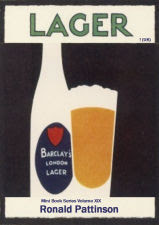Canadian Eddie Taylor’s acquisition of a British brewing empire began with he let the Hope & Anchor Brewery in Sheffield brew Carling Black Label under licence in 1952 . Initially, it had a very reasonable gravity of 1042º.
When sales were disappointing, mostly due to the small tied estate of Hope & Anchor, Taylor began buying breweries and their pubs. The United Breweries group he put together eventually merged with Charrington and later Bass to become Bass Charrington, the largest brewing enterprise in Britain. Carling was chosen as the group’s main Lager, a decision that catapulted it to become the leading Lager brand. A position it still holds today.
It wasn’t good news for Tennent’s, whom Taylor bought in 1963. Tennent’s had been a national Lager brand before the war, but it was pushed into the background by the selection of Carling Black Label as Bass Charrington’s flagship Lager.
Another victim of the merger was Charrington’s Pilsner Lager, which was first brewed in the 1950’s. That disappeared completely.
| British Lagers in the 1950's | ||||||||
| Year | Brewer | Beer | package | FG | OG | colour | ABV | App. Atten-uation |
| 1950 | Barclay Perkins | Lager | bottled | 1008 | 1036.1 | 11 B | 3.65 | 77.84% |
| 1950 | Barclay Perkins | Lager | bottled | 1008 | 1036.1 | 11 B | 3.65 | 77.84% |
| 1950 | Red Tower | Lager | bottled | 1008.2 | 1035.8 | 13 B | 3.58 | 77.09% |
| 1950 | Alloa Brewery | Light Lager | bottled | 1009.1 | 1043.4 | 7 B | 4.46 | 79.03% |
| 1950 | Alloa Brewery | Graham's Golden Lager | bottled | 1010.6 | 1040.6 | 9 B | 3.89 | 73.89% |
| 1952 | Carlings (Brewed in Sheffield) | Black Label Lager Beer | bottled | 1009.9 | 1042.3 | 10 B | 4.21 | 76.60% |
| 1952 | Alloa Brewery | Graham's Golden Lager | bottled | 1014.3 | 1039.2 | 15 B | 3.22 | 63.52% |
| 1954 | Steel Coulson | Lager Beer | bottled | 1004.3 | 1032 | 11 | 3.6 | 86.56% |
| 1955 | Tennent | Lager | bottled | 1007.7 | 1036.1 | 9 | 3.69 | 78.67% |
| 1956 | Flowers | Lager | bottled | 1014 | 1040.4 | 9 | 3.41 | 65.35% |
| 1956 | Flowers | Lager | bottled | 1014 | 1045.3 | 9 | 4.05 | 69.09% |
| 1956 | Red Tower | Red Tower Pilsner Lager | bottled | 1005.9 | 1031.2 | 10 | 3.29 | 81.09% |
| 1957 | Barclay Perkins | Pilsner Lager | bottled | 1006.3 | 1035 | 9 | 3.73 | 82.00% |
| 1957 | Flowers | Lager | bottled | 1017.9 | 1045 | 9 | 3.5 | 60.22% |
| 1957 | Flowers | Flowers Lager | bottled | 1017.5 | 1050 | 14 | 4.2 | 65.00% |
| 1957 | Graham's | Pilsener Lager | bottled | 1007.2 | 1035.6 | 9 | 3.69 | 79.78% |
| 1957 | Graham's Golden Lager | Pilsner Lager | bottled | 1007.3 | 1030.4 | 11 | 3 | 75.99% |
| 1957 | Charrington | Pilsner Lager | can | 1006.2 | 1035.5 | 4.5 | 3.81 | 82.54% |
| 1957 | Charrington | Pilsner Lager | can | 1005.8 | 1036 | 5 | 3.93 | 83.89% |
| 1957 | Barclay Perkins | Pilsner Lager | bottled | 1006.1 | 1034.3 | 6.5 | 3.67 | 82.22% |
| 1957 | McEwan & Younger | "MY" Export Lager | bottled | 1006.3 | 1033.6 | 13 | 3.55 | 81.25% |
| 1957 | McEwan & Younger | "MY" Export Lager | bottled | 1007.3 | 1035.2 | 13 | 3.62 | 79.26% |
| 1957 | McEwan & Younger | "MY" Export Lager | bottled | 1010.9 | 1033.8 | 13 | 2.96 | 67.75% |
| 1957 | Tennent | Lager Beer | bottled | 1008.6 | 1040.6 | 11 | 4.16 | 78.82% |
| 1958 | McEwan & Younger | MY Export Lager | can | 1010.5 | 1034.3 | 9 | 2.97 | 69.39% |
| 1959 | Carling (brewed in Sheffield) | Black Label Lager | bottled | 1004.4 | 1036.5 | 80 | 4.18 | 87.95% |
| 1959 | Lees | Lager | 1037 | |||||
| 1959 | Lees | Lager | 1037 | |||||
| Sources: | ||||||||
| Whitbread Gravity book held at the London Metropolitan Archives, document number LMA/4453/D/02/002 | ||||||||
| Lees brewing records | ||||||||
Like this? Then you'll love the book it comes from, Lager! (UK):


All bottles and cans - when did draught lager become widely available?
ReplyDeleteAnd did you see the BBC series "inside the factory" where they were at MolsonCoors in Burton showing how it was made (I would say brewed but that's another argument)
ReplyDeleteA sad day.
ReplyDeleteCan anyone actually describe the taste of Carling?
Chris Pickles,
ReplyDeletedraught Lager wasn't very common until the 1960s. Though Barclay Perkins had been making it since the 1920s. I suppose sales were just too small for it to be worthwhile in most pubs.
bigLurch Habercom,
ReplyDeleteI saw that programme. If you were paying attention, you could work out they were brewing it at high gravity, though they didn't explicitly say so. I worked it out using the volumes that they gave at various parts of the process. Bit disingenuous not to mention that explicitly.
Is there any truth in the story that the original Carling Black Label used Spruce Needles as an adjunct to flavour the drink?
ReplyDeletelkley Rob,
ReplyDeleteI'd find that very surprising. Sounds like a myth to me.